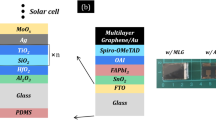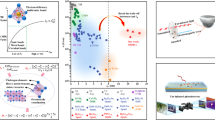Abstract
The fundamental challenge for designing transparent conductors used in photovoltaics, displays and solid-state lighting is the ideal combination of high optical transparency and high electrical conductivity. Satisfying these competing demands is commonly achieved by increasing carrier concentration in a wide-bandgap semiconductor with low effective carrier mass through heavy doping, as in the case of tin-doped indium oxide (ITO). Here, an alternative design strategy for identifying high-conductivity, high-transparency metals is proposed, which relies on strong electron–electron interactions resulting in an enhancement in the carrier effective mass. This approach is experimentally verified using the correlated metals SrVO3 and CaVO3, which, despite their high carrier concentration (>2.2 × 1022 cm−3), have low screened plasma energies (<1.33 eV), and demonstrate excellent performance when benchmarked against ITO. A method is outlined to rapidly identify other candidates among correlated metals, and strategies are proposed to further enhance their performance, thereby opening up new avenues to develop transparent conductors.
This is a preview of subscription content, access via your institution
Access options
Subscribe to this journal
Receive 12 print issues and online access
$259.00 per year
only $21.58 per issue
Buy this article
- Purchase on Springer Link
- Instant access to full article PDF
Prices may be subject to local taxes which are calculated during checkout





Similar content being viewed by others
References
Freeman, A. J., Poeppelmeier, K. R., Mason, T. O., Chang, R. P. H. & Marks, T. J. Chemical and thin-film strategies for new transparent conducting oxides. MRS Bull. 25, 45–51 (2000).
Ellmer, K. Past achievements and future challenges in the development of optically transparent electrodes. Nature Photon. 6, 809–817 (2012).
Mizoguchi, H., Kamiya, T., Matsuishi, S. & Hosono, H. A germanate transparent conductive oxide. Nature Commun. 2, 470 (2011).
Tadatsugu, M. Transparent conducting oxide semiconductors for transparent electrodes. Semicond. Sci. Technol. 20, S35 (2005).
Ginley, D. S., Hosono, H. & Paine, D. C. (eds) Handbook of Transparent Conductors (Springer, 2011).
Imada, M., Fujimori, A. & Tokura, Y. Metal–insulator transitions. Rev. Mod. Phys. 70, 1039–1263 (1998).
Brinkman, W. F. & Rice, T. M. Application of Gutzwiller’s variational method to the metal–insulator transition. Phys. Rev. B 2, 4302–4304 (1970).
Georges, A., Kotliar, G., Krauth, W. & Rozenberg, M. J. Dynamical mean-field theory of strongly correlated fermion systems and the limit of infinite dimensions. Rev. Mod. Phys. 68, 13–125 (1996).
Locquet, J.-P. et al. Doubling the critical temperature of La1.9Sr0.1CuO4 using epitaxial strain. Nature 394, 453–456 (1998).
Armitage, N., Fournier, P. & Greene, R. Progress and perspectives on electron-doped cuprates. Rev. Mod. Phys. 82, 2421–2487 (2010).
Eltsev, Y. et al. Anisotropic resistivity and Hall effect in MgB2 single crystals. Phys. Rev. B 66, 180504 (2002).
Zhuang, C. et al. Significant improvements of the high-field properties of carbon-doped MgB2 films by hot-filament-assisted hybrid physical–chemical vapor deposition using methane as the doping source. Supercond. Sci. Technol. 21, 082002 (2008).
Nakajima, M. et al. Unprecedented anisotropic metallic state in undoped iron arsenide BaFe2As2 revealed by optical spectroscopy. Proc. Natl Acad. Sci. USA 108, 12238–12242 (2011).
Analytis, J. G. et al. Bulk superconductivity and disorder in single crystals of LaFePO. Preprint at http://arXiv.org/abs/0810.5368 (2008).
Stemmer, S. Low-dimensional Mott material: Transport in ultrathin epitaxial LaNiO3 films. Appl. Phys. Lett. 96, 062114 (2010).
Nagai, I. et al. Highest conductivity oxide SrMoO3 grown by a floating-zone method under ultralow oxygen partial pressure. Appl. Phys. Lett. 87, 024105 (2005).
Radetinac, A., Takahashi, K. S., Alff, L., Kawasaki, M. & Tokura, Y. Single-crystalline CaMoO3 and SrMoO3 films grown by pulsed laser deposition in a reductive atmosphere. Appl. Phys. Exp. 3, 073003 (2010).
Fujita, K., Mochida, T. & Nakamura, K. High-temperature thermoelectric properties of NaxCoO2−δ single crystals. Japan J. Appl. Phys. 40, 4644–4647 (2001).
Hicks, C. W. et al. Quantum oscillations and high carrier mobility in the Delafossite PdCoO2 . Phys. Rev. Lett. 109, 116401 (2012).
Lightsey, P., Lilienfeld, D. & Holcomb, D. Transport properties of cubic NaxWO3 near the insulator–metal transition. Phys. Rev. B 14, 4730–4732 (1976).
Tashman, J. et al. Epitaxial growth of VO2 by periodic annealing. Appl. Phys. Lett. 104, 063104 (2014).
Sipos, B. et al. From Mott state to superconductivity in 1T-TaS2 . Nature Mater. 7, 960–965 (2008).
Basov, D. N., Averitt, R. D., Van Der Marel, D., Dressel, M. & Haule, K. Electrodynamics of correlated electron materials. Rev. Mod. Phys. 83, 471–541 (2011).
Nishimura, K., Yamada, I., Oka, K., Shimakawa, Y. & Azuma, M. High-pressure synthesis of BaVO3: A new cubic perovskite. J. Phys. Chem. Solids 75, 710–712 (2014).
Wissgott, P., Kuneš, J., Toschi, A. & Held, K. Dipole matrix element approach versus Peierls approximation for optical conductivity. Phys. Rev. B 85, 205133 (2012).
Fujimori, A. et al. Evolution of the spectral function in Mott–Hubbard systems with d1 configuration. Phys. Rev. Lett. 69, 1796–1799 (1992).
O’Connor, B., Haughn, C., An, K.-H., Pipe, K. P. & Shtein, M. Transparent and conductive electrodes based on unpatterned, thin metal films. Appl. Phys. Lett. 93, 223304 (2008).
Fuchs, K. The conductivity of thin metallic films according to the electron theory of metals. Proc. Camb. Phil. Soc. 34, 100–108 (1938).
Qazilbash, M. et al. Electronic correlations in the iron pnictides. Nature Phys. 5, 647–650 (2009).
Haacke, G. New figure of merit for transparent conductors. J. Appl. Phys. 47, 4086–4089 (1976).
Sondheimer, E. H. The mean free path of electrons in metals. Adv. Phys. 1, 1–42 (1952).
Sennett, R. S. & Scott, G. D. The structure of evaporated metal films and their optical properties. J. Opt. Soc. Am. 40, 203–210 (1950).
Fukuda, K., Lim, S. H. N. & Anders, A. Coalescence of magnetron-sputtered silver islands affected by transition metal seeding (Ni, Cr, Nb, Zr, Mo, W, Ta) and other parameters. Thin Solid Films 516, 4546–4552 (2008).
Formica, N. et al. Ultrastable and atomically smooth ultrathin silver films grown on a copper seed layer. ACS Appl. Mater. Interfaces 5, 3048–3053 (2013).
Wu, H. et al. A transparent electrode based on a metal nanotrough network. Nature Nanotech. 8, 421–425 (2013).
Lichtenberg, F., Catana, A., Mannhart, J. & Schlom, D. Sr2RuO4: a metallic substrate for the epitaxial growth of YBa2Cu3O7−δ . Appl. Phys. Lett. 60, 1138–1140 (1992).
Koster, G. et al. Structure, physical properties, and applications of SrRuO3 thin films. Rev. Mod. Phys. 84, 253–298 (2012).
Zhu, X. et al. Chemical solution deposition of transparent and metallic La0.5Sr0.5TiO3+x/2 films using topotactic reduction. J. Am. Ceram. Soc. 92, 800–804 (2009).
Stewart, M. et al. Optical study of strained ultrathin films of strongly correlated LaNiO3 . Phys. Rev. B 83, 075125 (2011).
Serway, R. A. Principles of Physics (Saunders College Pub, 1998).
Ehrenreich, H. & Philipp, H. Optical properties of Ag and Cu. Phys. Rev. 128, 1622–1629 (1962).
Johnson, P. B. & Christy, R.-W. Optical constants of the noble metals. Phys. Rev. B 6, 4370–4379 (1972).
Ordal, M. A., Bell, R. J., Alexander, R. W., Long, L. L. & Querry, M. R. Optical properties of fourteen metals in the infrared and far infrared: Al, Co, Cu, Au, Fe, Pb, Mo, Ni, Pd, Pt, Ag, Ti, V, and W. Appl. Opt. 24, 4493–4499 (1985).
Ellmer, K. Resistivity of polycrystalline zinc oxide films: current status and physical limit. J. Phys. D 34, 3097–3108 (2001).
Preissler, N., Bierwagen, O., Ramu, A. T. & Speck, J. S. Electrical transport, electrothermal transport, and effective electron mass in single-crystalline In2O3 films. Phys. Rev. B 88, 085305 (2013).
Igasaki, Y. & Saito, H. The effects of deposition rate on the structural and electrical properties of ZnO: Al films deposited on (1120) oriented sapphire substrates. J. Appl. Phys. 70, 3613–3619 (1991).
Ohta, H. et al. Highly electrically conductive indium–tin–oxide thin films epitaxially grown on yttria-stabilized zirconia (100) by pulsed-laser deposition. Appl. Phys. Lett. 76, 2740–2742 (2000).
Kim, H. et al. Effect of film thickness on the properties of indium tin oxide thin films. J. Appl. Phys. 88, 6021–6025 (2000).
Guo, E.-J. et al. Structure and characteristics of ultrathin indium tin oxide films. Appl. Phys. Lett. 98, 011905–011903 (2011).
Ohta, H., Orita, M., Hirano, M. & Hosono, H. Surface morphology and crystal quality of low resistive indium tin oxide grown on yittria-stabilized zirconia. J. Appl. Phys. 91, 3547–3550 (2002).
Polyanskiy, M. N. Refractive Index Database (RefractiveIndex.INFO, accessed 29 February 2015); http://refractiveindex.info
Refractive Index of ITO, Indium Tin Oxide, InSnO (Filmetrics, accessed 29 April 2015); http://www.filmetrics.com/refractive-index-database/ITO/Indium-Tin-Oxide-InSnO
Moyer, J. A., Eaton, C. & Engel-Herbert, R. Highly conductive SrVO3 as a bottom electrode for functional Perovskite oxides. Adv. Mater. 25, 3578–3582 (2013).
Brahlek, M., Zhang, L., Eaton, C., Zhang, H.-T. & Engel-Herbert, R. Accessing a growth window for SrVO3 thin films. Appl. Phys. Lett. 107, 143108 (2015).
Kresse, G. & Furthmüller, J. Efficient iterative schemes for ab initio total-energy calculations using a plane-wave basis set. Phys. Rev. B 54, 11169–11186 (1996).
Acknowledgements
We gratefully acknowledge support by the Office of Naval Research through Grant No. N00014-11-1-0665 (L.Z., Y.Z., C.E., L.G., K.M.R., V.G., R.E.-H.), the National Science Foundation through the Penn State MRSEC Program DMR-1420620 (H.-T.Z., W.Z., M.H.W.C.) and Grant No. DMR-1352502 (L.Z., R.E.-H.), the Department of Energy through Grant DE-SC0012375 (M.B., R.E.-H.), the University of Toledo start up funds and the Ohio Department of Development (ODOD) Ohio Research Scholar Program entitled Northwest Ohio Innovators in Thin Film Photovoltaics, Grant No. TECH 09-025 (A.B., H.F.H., N.P.). We thank R. Averitt for stimulating discussions.
Author information
Authors and Affiliations
Contributions
L.Z. and R.E.-H. conceived and designed the experiments. L.Z., H.-T.Z. and C.E. synthesized SrVO3 thin films. L.Z. and M.B. synthesized CaVO3 thin films. L.Z. performed XRD and AFM measurements. Y.Z. performed DFT calculations and Y.Z. and K.M.R. analysed the theoretical results. L.G. and V.G. performed optical transmission measurements. W.Z. and L.Z. performed the electrical transport measurements, and W.Z., L.Z. and M.H.W.C. analysed the results. A.B., H.F.H. and N.J.P. performed spectroscopic ellipsometry measurements and analysed the results for SrVO3 thin films. Y.X.Z. performed spectroscopic ellipsometry measurements and analysed the results for CaVO3 thin films. L.Z. and R.E.-H. wrote the manuscript and all authors gave comments on the manuscripts and approved the final version.
Corresponding author
Ethics declarations
Competing interests
The authors declare no competing financial interests.
Supplementary information
Supplementary Information
Supplementary Information (PDF 2272 kb)
Rights and permissions
About this article
Cite this article
Zhang, L., Zhou, Y., Guo, L. et al. Correlated metals as transparent conductors. Nature Mater 15, 204–210 (2016). https://doi.org/10.1038/nmat4493
Received:
Accepted:
Published:
Issue Date:
DOI: https://doi.org/10.1038/nmat4493
This article is cited by
-
Electronic structure of superconducting VN(111) films
Discover Nano (2024)
-
Modulated transparent conductive zinc oxide films for efficient water splitting
Applied Physics A (2024)
-
Strong conductivity enhancement of La-doped BaSnO3 transparent films on Al2O3 with the assistance of templated epitaxy for electromagnetic shielding in extreme environments
Nano Convergence (2023)
-
Layered metals as polarized transparent conductors
Nature Communications (2023)
-
Far-infrared transparent conductors
Light: Science & Applications (2023)



